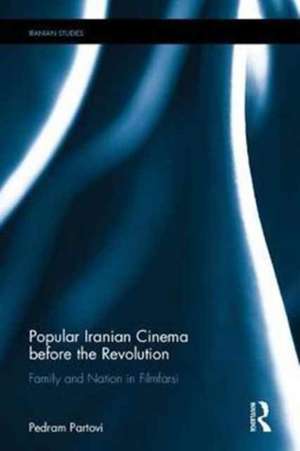Popular Iranian Cinema before the Revolution: Family and Nation in Fīlmfārsī: Iranian Studies
Autor Pedram Partovien Limba Engleză Hardback – 13 iun 2017
This book challenges the idea that filmfarsi is detached from the past and present of Iranians. Far from being escapist Hollywood fare merely translated into Persian, it claims that the better films of this supposed genre must be taken as both a subject of, and source for, modern Iranian history. It argues that they have an appeal that relies on their ability to rearticulate traditional courtly and religious ideas and forms to problematize in unexpectedly complex and sophisticated ways the modernist agenda that secular nationalist elites wished to impose on their viewers. Taken seriously, these films raise questions about standard treatments of Iran's modern history.
By writing popular films into Iranian history, this book advocates both a fresh approach to the study of Iranian cinema, as well as a rethinking of the modernity/tradition binary that has organized the historiography of the recent past. It will appeal to those interested in Iranian cinema, Iranian history and culture, and, more broadly, readers dissatisfied with a dichotomous approach to modernity.
| Toate formatele și edițiile | Preț | Express |
|---|---|---|
| Paperback (1) | 272.43 lei 6-8 săpt. | |
| Taylor & Francis – 12 dec 2019 | 272.43 lei 6-8 săpt. | |
| Hardback (1) | 848.57 lei 6-8 săpt. | |
| Taylor & Francis – 13 iun 2017 | 848.57 lei 6-8 săpt. |
Din seria Iranian Studies
-
 Preț: 154.25 lei
Preț: 154.25 lei -
 Preț: 310.03 lei
Preț: 310.03 lei - 18%
 Preț: 1053.92 lei
Preț: 1053.92 lei - 18%
 Preț: 1108.37 lei
Preț: 1108.37 lei - 25%
 Preț: 823.63 lei
Preț: 823.63 lei - 25%
 Preț: 823.99 lei
Preț: 823.99 lei -
 Preț: 449.41 lei
Preț: 449.41 lei - 18%
 Preț: 1068.18 lei
Preț: 1068.18 lei - 18%
 Preț: 997.90 lei
Preț: 997.90 lei -
 Preț: 389.38 lei
Preț: 389.38 lei - 18%
 Preț: 1055.51 lei
Preț: 1055.51 lei - 12%
 Preț: 299.52 lei
Preț: 299.52 lei -
 Preț: 442.68 lei
Preț: 442.68 lei - 18%
 Preț: 1059.84 lei
Preț: 1059.84 lei - 25%
 Preț: 770.09 lei
Preț: 770.09 lei -
 Preț: 341.55 lei
Preț: 341.55 lei - 18%
 Preț: 1165.97 lei
Preț: 1165.97 lei -
 Preț: 437.13 lei
Preț: 437.13 lei - 18%
 Preț: 1168.76 lei
Preț: 1168.76 lei -
 Preț: 436.14 lei
Preț: 436.14 lei - 18%
 Preț: 1117.07 lei
Preț: 1117.07 lei -
 Preț: 478.86 lei
Preț: 478.86 lei - 25%
 Preț: 570.60 lei
Preț: 570.60 lei - 18%
 Preț: 1114.70 lei
Preț: 1114.70 lei - 26%
 Preț: 822.01 lei
Preț: 822.01 lei - 18%
 Preț: 1000.27 lei
Preț: 1000.27 lei - 18%
 Preț: 1060.52 lei
Preț: 1060.52 lei -
 Preț: 412.70 lei
Preț: 412.70 lei - 18%
 Preț: 1054.71 lei
Preț: 1054.71 lei - 22%
 Preț: 328.20 lei
Preț: 328.20 lei -
 Preț: 430.94 lei
Preț: 430.94 lei - 18%
 Preț: 1055.51 lei
Preț: 1055.51 lei - 18%
 Preț: 1002.63 lei
Preț: 1002.63 lei - 25%
 Preț: 685.71 lei
Preț: 685.71 lei - 18%
 Preț: 1067.14 lei
Preț: 1067.14 lei - 18%
 Preț: 1118.65 lei
Preț: 1118.65 lei - 18%
 Preț: 1054.75 lei
Preț: 1054.75 lei
Preț: 848.57 lei
Preț vechi: 1140.94 lei
-26% Nou
Puncte Express: 1273
Preț estimativ în valută:
162.38€ • 167.77$ • 135.08£
162.38€ • 167.77$ • 135.08£
Carte tipărită la comandă
Livrare economică 19 martie-02 aprilie
Preluare comenzi: 021 569.72.76
Specificații
ISBN-13: 9781138230538
ISBN-10: 1138230537
Pagini: 244
Ilustrații: 46
Dimensiuni: 156 x 234 x 19 mm
Greutate: 0.5 kg
Ediția:1
Editura: Taylor & Francis
Colecția Routledge
Seria Iranian Studies
Locul publicării:Oxford, United Kingdom
ISBN-10: 1138230537
Pagini: 244
Ilustrații: 46
Dimensiuni: 156 x 234 x 19 mm
Greutate: 0.5 kg
Ediția:1
Editura: Taylor & Francis
Colecția Routledge
Seria Iranian Studies
Locul publicării:Oxford, United Kingdom
Public țintă
Postgraduate and UndergraduateCuprins
1. Introduction: Imagining Iran in Popular Film
2. Making Popular Film in Iran
3. Heroes and Heroines of the Nation
4. Martyrdom and Self-Sacrifice
5. Exile
6. Fate and Agency
Concluding Remarks
Bibliography
2. Making Popular Film in Iran
3. Heroes and Heroines of the Nation
4. Martyrdom and Self-Sacrifice
5. Exile
6. Fate and Agency
Concluding Remarks
Bibliography
Notă biografică
Pedram Partovi is an Assistant Professor in the Department of History at the American University
Descriere
This book sheds light on the prolific but little studied Iranian popular cinema of the 1960s and 70s. Critics generally dismiss such films, best known for their songs and melodramatic plots, as shallow, derivative entertainment. The sarcastic moniker filmfarsi (“Persian film”) was even employed to refer to the popular cinema, asserting its marginality in Iran and the international film world. Yet this book argues that many filmfarsi titles had a cognitive and emotional appeal that relied on their ability to re-articulate “traditional” aesthetic and religious ideas and forms to problematize the modernist agenda of secular nationalist elites.
